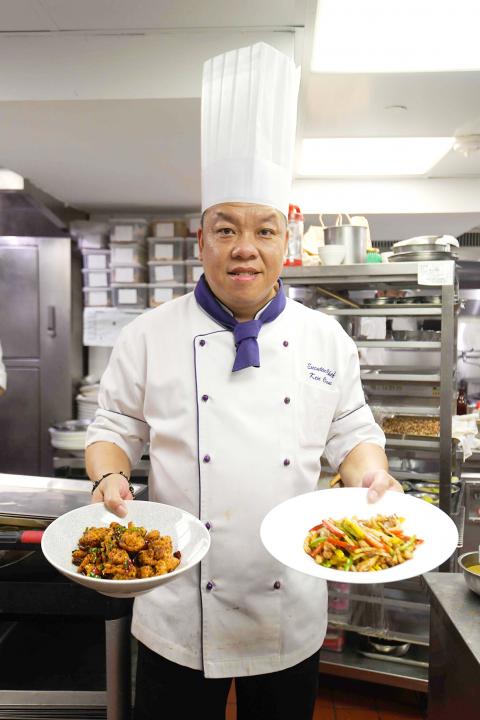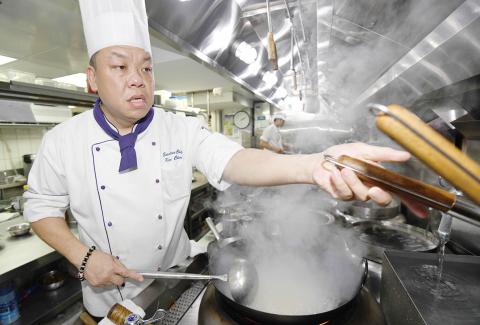Ken Chan (陳偉強) has come a long way since he started out wheeling a trolley in a dim sum restaurant, becoming the first chef in his adopted home of Taiwan to win three Michelin stars.
Hong Kong-born Chan, 53, worked through tough apprenticeships back home before rising through the ranks on Taiwan’s culinary scene over the past three decades to become executive chef at luxury five-star hotel restaurant Le Palais in Taipei.
Serving mainly Cantonese cuisine as well as Sichuan, Fuzhou and Taiwanese dishes, Le Palais became the first and only restaurant in Taiwan to receive three stars when Michelin launched its Taipei guide earlier this year, describing the food as “truly outstanding.”

Photo: AFP
Chan’s menu is relatively affordable compared with three-star restaurants in the rest of the world, with dishes ranging from steamed prawn dumplings and baked barbecue pork buns, priced from NT$250, to an eight-course set including lobster salad, bird’s nest soup, braised abalone with goose foot and steamed tiger grouper at NT$6,980.
Taiwan’s most-recognized chef, Andre Chiang (江振誠), famously gave up the two Michelin stars attached to his eponymous Restaurant Andre in Singapore, closing it in February to focus on other projects, including his Taipei restaurant RAW.
But Chan says he believes receiving the stars will boost the island’s burgeoning foodie credentials.

Photo: AFP
“It inspires everybody to aim higher and higher,” he said.
Chan attributes his accolade to “luck,” but it is also testament to perseverance.
After dropping out of school in Hong Kong aged 12, Chan began working in a restaurant in the city, pushing a dim sum trolley around the tables from which customers would choose dishes.
He already had a love of cooking passed down from his mother and remembers how she would give him two Hong Kong dollars to buy ingredients in the market to feed the family, as she was working full-time to make ends meet.
Having to carefully think how to spend the money to create the best meal has influenced his approach in the kitchen now, says Chan. “I told my staff ‘You shouldn’t just aim to finish the job but should do it well, as if you were cooking for your parents,’” he said.
A DYING ART?
Life in the Hong Kong restaurant business was far from glamorous.
Chan was tasked with washing the underwear of a chef he worked under and recalls being hit on the head with a spatula when his “master” was in a bad mood, even being thrown into a river for making mistakes.
“Back then if you wanted to learn something, you had to beg the master to teach you,” he said. “I had to buy drinks and fruit to treat my masters so they would casually teach me one or two steps.”
Chan believes young people now are too pampered and unable to handle pressure. “I have to ask them to learn,” he said.
With just HK$270 (US$34) in his pocket, Chan began a new chapter in Taiwan 30 years ago at the age of 23, after his mother died and his girlfriend dumped him. His first job was as a chef in a vegetarian restaurant and he recalls feeling isolated because he only spoke Cantonese, the dominant language in Hong Kong, not Mandarin which is spoken in Taiwan.
But he says a sense of pride made him stay and he began to build a reputation for his Cantonese cuisine.
Chan worked up to becoming head chef at another five-star hotel restaurant in Taipei, before taking the executive chef position at Le Palais in 2010.
At the time, the restaurant had only been open for a few months and Chan was despondent over the lack of customers on his first day.
“I didn’t go home that night and locked myself in the office to ponder over how to run the restaurant,” he remembers. He came up with a new menu of 27 dishes and replaced around a third of the staff as part of a major overhaul.
Chan worries that traditional skills in Cantonese and Taiwanese cooking will eventually be lost as the old masters age and young chefs struggle to create the same flavors. But for now, he says his own goal is to keep reinventing himself. “I don’t see myself as a veteran chef,” he said.
“My mentality is that I am like a child just learning to walk and I have to constantly learn new things.”

One of the biggest sore spots in Taiwan’s historical friendship with the US came in 1979 when US president Jimmy Carter broke off formal diplomatic relations with Taiwan’s Republic of China (ROC) government so that the US could establish relations with the People’s Republic of China (PRC). Taiwan’s derecognition came purely at China’s insistence, and the US took the deal. Retired American diplomat John Tkacik, who for almost decade surrounding that schism, from 1974 to 1982, worked in embassies in Taipei and Beijing and at the Taiwan Desk in Washington DC, recently argued in the Taipei Times that “President Carter’s derecognition

This year will go down in the history books. Taiwan faces enormous turmoil and uncertainty in the coming months. Which political parties are in a good position to handle big changes? All of the main parties are beset with challenges. Taking stock, this column examined the Taiwan People’s Party (TPP) (“Huang Kuo-chang’s choking the life out of the TPP,” May 28, page 12), the Democratic Progressive Party (DPP) (“Challenges amid choppy waters for the DPP,” June 14, page 12) and the Chinese Nationalist Party (KMT) (“KMT struggles to seize opportunities as ‘interesting times’ loom,” June 20, page 11). Times like these can

JUNE 30 to JULY 6 After being routed by the Japanese in the bloody battle of Baguashan (八卦山), Hsu Hsiang (徐驤) and a handful of surviving Hakka fighters sped toward Tainan. There, he would meet with Liu Yung-fu (劉永福), leader of the Black Flag Army who had assumed control of the resisting Republic of Formosa after its president and vice-president fled to China. Hsu, who had been fighting non-stop for over two months from Taoyuan to Changhua, was reportedly injured and exhausted. As the story goes, Liu advised that Hsu take shelter in China to recover and regroup, but Hsu steadfastly

You can tell a lot about a generation from the contents of their cool box: nowadays the barbecue ice bucket is likely to be filled with hard seltzers, non-alcoholic beers and fluorescent BuzzBallz — a particular favorite among Gen Z. Two decades ago, it was WKD, Bacardi Breezers and the odd Smirnoff Ice bobbing in a puddle of melted ice. And while nostalgia may have brought back some alcopops, the new wave of ready-to-drink (RTD) options look and taste noticeably different. It is not just the drinks that have changed, but drinking habits too, driven in part by more health-conscious consumers and